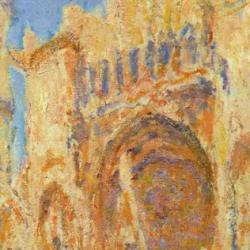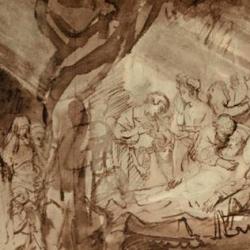Nearly every student of Israel and the ANE emphasizes the uniqueness of Israel’s aniconic worship. Explaining the significance of it is much more difficult. As Ronald Hendel summarizes ( CBQ 1988), scholars have offered several rationales for the exclusion of images from Israel’s worship: “(1) Yahweh is a god of history. (2) Yahweh cannot be magically manipulated. (3) Yahweh is transcendent. (4) Yahweh is Israel’s god in contrast to the gods of Canaan.”
None of these works. In response to Zimmerli’s and others’ contention that Yahweh is a God of history rather than myth, Hendel writes, “In the last two decades, however, this view has increasingly come under attack. B. Albrektson and others have demonstrated that Israel’s religion was not unusual among the ancient Near Eastern religions in regarding history as an important forum of divine activity; rather, this notion is to be regarded as ‘part of the common theology of the ancient Near East.’ Yahweh is not distinguishable from Marduk, Ashur, or the other national gods in his activity in ‘history.’”
Zimmerli also offers the second rationale: Yahweh cannot be manipulated. This doesn’t seem to hold either: “J. J. M. Roberts. Roberts asks the question: ‘Were the pagan gods, in fact, more susceptible to manipulation than Yahweh, and was the pagan cult a more blatant attempt to gain control over the deity than the Israelite cult?’ Based on a survey of the evidence, Roberts answers in the negative. Israelite religion, with its various divinatory techniques, attempted to discern the will of Yahweh, just as other Near Eastern religions attempted to discern the will of their gods. Roberts writes that many biblical theologians ‘have basically misunderstood divination.. . when they describe it as a way of tricking or coercing the deity into revelation.’”
Von Rad goes with the “transcendence view,” the notion that Yahweh is too transcendent and hidden to be captured by an image. For von Rad, aniconic religion points to a completely different view of the world within Israel. Again, Hendel says, this is common to ANE religion: “The concept of transcendence is indeed valid in describing aspects of Israelite religion. The flaw in von Rad’s view is that transcendence is a quality that applies as well to the other religions of the ancient Near East.” Finally, to the notion that Israel’s aniconic stance is anti-Canaanite (Keel), Hendel quotes from Mary Douglas: “It is no explanation to represent Israel as a sponge at one moment and as a repellent the next, without explaining why it soaked up this foreign element but repelled that one.”
-In place of these theories, Hendel offers a political explanation. He focuses on the ark of the covenant as the central cultic object in early Israel. He points to parallels between the biblical talk of Yahweh enthroned on the cherubim and Phoenician and Canaanite images of the king seated on a cherubim throne, feet on a footstool. From the sixth century BC on, further, numerous images have been found that depict a bearded god sitting on a similar throne, hand held out in blessing. Such images have been found in Lebanon, Cyprus, Sicily, Sardinia, Carthage, and elsewhere where Phoenician civilization touched down. Kings, as the representatives of the god, were pictured in a similar posture and on a similar throne.
This provides Hendel with his explanation for Israel’s hostility to icons: “the iconography of the cherub throne implies two interconnected images: the image of the god and the image of the king. In early Israel there existed a strong bias against the institution of kingship. Once the image of the king was rejected, the image of the god, which was essentially a mirror image of the king, was also rejected. Since there was no place in the early Israelite universe for a king, the divine image that symbolized the authority of the king was prohibited. In short, the motive for the aniconic tradition in early Israel was the bias against kingship and its iconography.”
After summarizing Henri Frankfort’s work on ancient kingship, Hendel goes on: “A. L. Oppenheim commented that in Mesopotamia the divine image ‘lived the life of a king.’ The image lived in its sanctuary, surrounded by statues of family and courtiers; it was taken on processions through the temple compounds and through the city; it was served its meals in royal style, after which the food was served to the king; it was married to its spouse in elaborate ceremony; in one known instance it was even carried out to the royal game park to hunt animals. In Assyrian seals and reliefs we often find the king and the god Ashur pictured in identical attire and pose, mirror images of each other, whether attacking enemies or riding in a victory procession.”
“The close relationship between the image of the god and the image of the king is an important part of the ideology of kingship in the ancient Near East. The king was regarded as the earthly representative of the gods, and as such the image of the god was a symbol of the legitimacy of the earthly king. The divine image was pictured and was treated as a king, therefore serving as a reminder of the divine authority of the king.” He cites as the strongest evidence “a 13th-century Middle Assyrian text, the ‘Tukulti-Ninurta Epic,’ that described the king as the salarti Illil däru, ‘the eternal image of Enlil.’ The phrase salarti DN, ‘image of the god,’ is also used of the king in later neo-Assyrian and neo-Babylonian texts, but the meaning of the phrase reflects the common royal ideology of Mesopotamia—and, we might add, the common West-Semitic ideology as well. The ‘image of the god’ was the king himself.”
Hendel concludes: “The bias against kingship was distinctive of Israel among the nations of the ancient Near East. The prohibition of divine images was also distinctive in the Near East. It is perhaps not surprising to discover that these two traits had a common root. The prohibition of the image of Yahweh was a reflection, on the level of religious iconography, of the early Israelite bias against the institution and the ideology of kingship.”
Hendel may be on to something in connecting Israel’s political views with its opposition to images in worship. But if so, the connections will have to be considerably modified. The Old Testament is not in principle hostile to kingship, and Solomon’s throne and palace pick up on some of the same theology of kingship that is found elsewhere in the ANE – Solomon is a “son” of Yahweh who lives near his Father’s house and who sits on a leonine throne that resembles the cherub throne of Yahweh.











